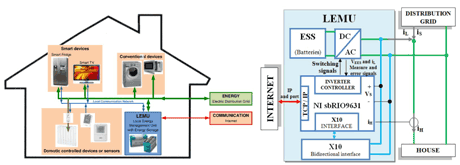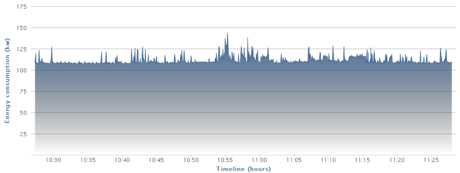by Vicente Botón, Máximo Pérez, Adolfo Lozano-Tello and Enrique Romero
In order to transition the present day electrical grids into the smart grids of the future, it is essential that we develop effective energy storage systems. Intelligent software systems can be employed to manage stored energy and smart domestic devices in order to optimize local energy consumption whilst taking into account user behaviour and environmental conditions. An effective energy storage system will provide economic benefits and enable us to optimize use of the distribution grid
{jcomments on}.
Energy storage systems (ESS) [1,2] are necessary to facilitate integration of both distributed generation systems, based on renewable energy sources, and smart devices, located in houses, residential and commercial buildings, into the power grid. Such systems can thereby help to manage the load profile, optimizing the performance of the distribution grid. This kind of system is typically associated with distributed generation plants - mainly with photovoltaic installations - but an ESS could also be used in the absence of an energy generation system, with the aim of smoothing the load curve or even controlling energy consumption depending on its price-by-hour.
These environments require both the ability to adapt themselves to the residents’ consumption habits and the versatility to make decisions in a variety of situations. In this sense, identifying consumption patterns within a sequence of events in order to predict future peaks on the load curve can help us achieve energy optimization. This information could enable the system to recognize power consumption patterns and determine the best way to smooth future peaks. Identification of these patterns obviously requires a previous task of learning. In a smart grid environment, learning means that the system has to acquire knowledge about the use of energy and common behaviour of the electric distribution grids in an unobtrusive and transparent way.
An appropriate way to control smart houses is to use ontologies [3] to classify the types of appliances and sensors and their functionality to gain an understanding of the load profile of a house or residential building. Ontologies and SWRL (Semantic Web Rule Language) rules provide a precise definition of smart grid taxonomy and are reusable, so other systems can use them to classify their own components and to build rules that will allow new information to be inferred. One proposed system to integrate smart home devices and energy storage systems is IntelliDomo [3]. This system (see Figure 1) comprises Local Energy Management units (LEMU), which are located in houses or residential buildings with the aim of controlling the load curve, and a central system that receives data from a group of LEMUs via a conventional connection, eg ADSL, operated by telephone companies, that is typically found in houses and residential buildings. The data conveyed by the LEMUs are analysed by the central system using behavioural algorithms in order to decide on an action and this information is also communicated to the distribution grid operator to enable it to optimize the load curves. In this way, the system becomes a Central Energy Management and Intelligent System (CEMIS).

Figure 1: Schematic diagram of the interconnection of home appliances, and the local energy management unit (with energy storage system).
Using this system, each event captured by sensors and actuators is recorded. With these data, there is a learning module which incorporates algorithms in order to acquire users’ habits and automatically generate production rules for behaviour patterns to anticipate the user’s periodic actions. As a result, the system can adapt to changes in the identified patterns based on the user implicit and explicit feedback. The algorithms will analyse this dataset and look for frequent peaks in the load curves (see Figure 2). Once they recognize the patterns, they will design a strategy to coordinate the behaviour of the LEMU and optimize the use of the resources. This strategy is carried out by generating SWRL rules that automate the corresponding actions. Therefore, the Energy Optimization Module (EOM) will send the results of the data mining process to the IntelliDomoRules tool, which can build the rules and save them into the ontology. Thus, IntelliDomo can control several LEMUS to optimize energy consumption and manage smart home devices remotely.

Figure 2: Example of the power consumed over time in the IntelliDomo system used to analyse the behaviour of the installation.
Link:
http://www.intellidomo.es
References:
[1] C. Pieper, H. Rubel: “Revisiting Energy Storage: There Is a Business Case”, the Boston Consulting Group, (2011)
[2] M. Guerrero, et al: “Supercapacitors: Alternative Energy Storage Systems”, PRZEGLĄD ELEKTROTECHNICZNY, 2009
[3] A. Lozano-Tello, V. Boton: “Analysis of Sequential Events for the Recognition of Human Behaviour Patterns in Home Automation Systems” in proc. DCAI 2012, AISC 151, Springer-Verlag. pp 511-518, 2012.
Please contact:
Adolfo Lozano-Tello
Telefonica Chair of Extremadura University, Spain
E-mail:











